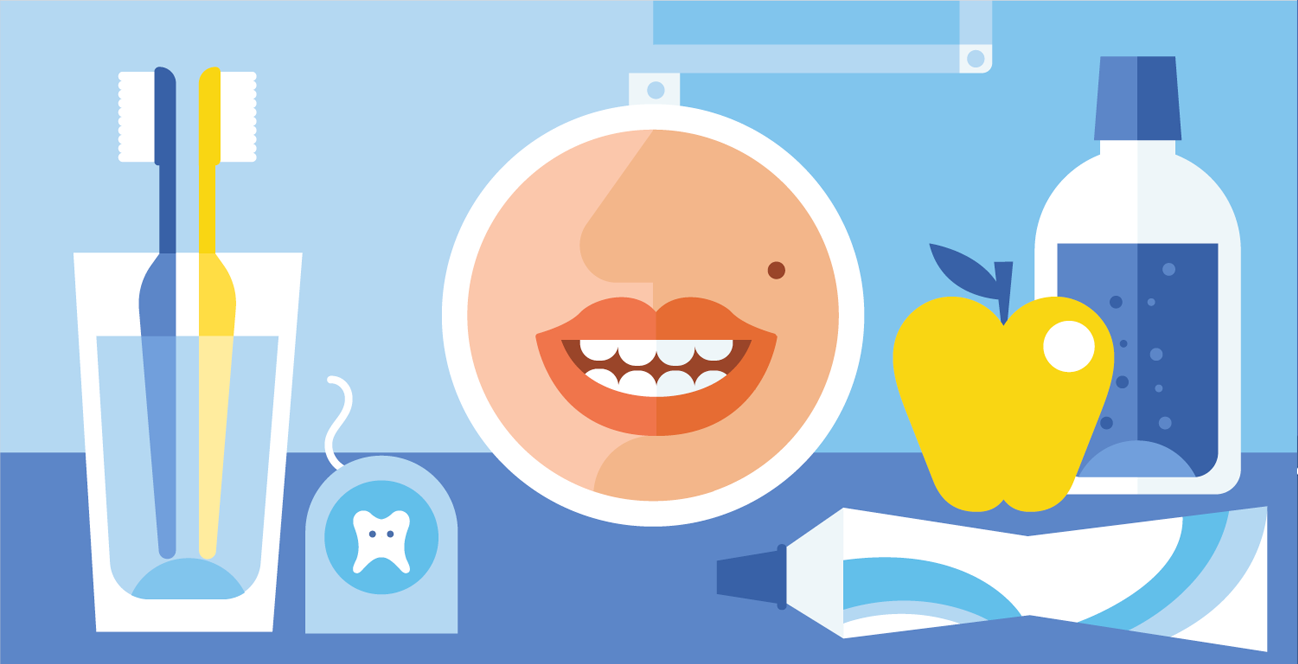It’s all about dental health
Last Updated : 01 June 20061. What do we mean by dental health?
Dental health refers to all aspects of the health and functioning of our mouth especially the teeth and gums. Apart from working properly to enable us to eat, speak, laugh (look nice), teeth and gums should be free from infection, which can cause dental caries, inflammation of gums, tooth loss and bad breath.
Dental caries, also known as tooth decay or cavities, is the most common disorder affecting the teeth. The main factors controlling the risk of dental caries are oral hygiene, exposure to fluoride and a moderate frequency of consumption of cariogenic foods.
Teeth are also affected by “tooth wear” or erosion. This condition is a normal part of aging where tooth enamel is lost due to exposure from acids other than those produced by plaque.
Attrition and abrasion are other forms of tooth wear. Attrition occurs when teeth are eroded by tooth-to-tooth contact such as teeth grinding. Abrasion is caused by external mechanical factors such as incorrect tooth brushing.
Periodontal disease, also known as gum disease, is caused by infection and inflammation of the gingiva (gum), the periodontal connective tissues and the alveolar bone. Periodontal disease can lead to tooth loss.
2. Why is dental health important for general health and well being?
The health of our teeth and mouth are linked to overall health and well-being in a number of ways. The ability to chew and swallow our food is essential for obtaining the nutrients we need for good health. Apart from the impact on nutritional status, poor dental health can also adversely affect speech and self-esteem. Dental diseases impose both financial and social burdens as treatment is costly and both children and adults may miss time from school or work because of dental pain.
3. Why and how are dental caries formed?
Dental caries, the most common disorder affecting the teeth, is an infectious transmissible disease where acids produced by bacteria dissolve the teeth.
Certain bacteria such as Streptococci mutans and Lactobacilli, can be transmitted for example from parents to children. These bacteria are cariogenic, which means decay-causing. They initiate a sticky film, known as dental plaque, on the surface of the tooth. Bacteria in dental plaque use fermentable carbohydrates to form acids. Fermentable carbohydrates are sugars and other carbohydrates from food and drink that can be fermented by bacteria. The acids formed dissolve minerals such as calcium and phosphate from the tooth. This is called demineralisation.
But tooth decay is not inevitable. Saliva clears food debris from the mouth, neutralises acids produced from plaque bacteria and provides calcium and phosphate to the teeth in a process called remineralisation. Saliva also acts as a reservoir for fluorides from toothpaste or from fluoridated water. Fluoride helps control dental caries by remineralising the teeth and inhibiting bacterial acid production, which reduces or slows the decay process.
Tooth decay only occurs when the process of demineralisation exceeds remineralisation over a period of time.
4. What factors affect the development of dental caries?
The following factors have an important impact on dental health:
4.1. Individual factors
Susceptibility to dental caries varies between individuals and between different teeth within one person’s mouth. The shape of the jaw and oral cavity, tooth structure and the quantity and quality of saliva are all important in determining why some teeth are simply more susceptible to decay than others. For example, some teeth may have pits, small cracks or fissures that allow bacteria and acids to infiltrate more easily. In some cases, the structure of the jaw/dentition renders teeth more difficult to clean or floss.
The quantity and quality of saliva determines the extent to which teeth remineralise. For example relatively fewer caries are generally found in the lower front part of the mouth where teeth are more exposed to saliva.
The type and number of caries-causing bacteria present in the mouth is also relevant. All bacteria can turn carbohydrates into acids but certain families of bacteria such as Streptococci and Lactobacilli are more powerful acid producers. The presence of this type of bacteria in plaque increases the risk of decay. Some people have higher levels of decay-causing bacteria than others due to neglected or inappropriate oral hygiene.
4.2. Oral hygiene and use of fluoride
In recent years there has been a reduction in the incidence of dental caries in most European countries. An increase in oral hygiene including regular brushing and flossing to remove plaque and the use of fluoridated toothpaste, combined with regular dental check-ups, is thought to be responsible for the improvement.
Fluoride inhibits demineralisation, encourages remineralisation and increases the hardness of the tooth enamel making it less acid soluble. The proper amount of fluoride helps prevent and control caries. Fluoride can be supplied systemically through fluoridated community drinking water, other fluoridated beverages or by supplementation. Alternatively it can be provided topically direct to the tooth surface via toothpaste, mouth rinses, gels and varnishes.
In some countries, salt, milk or other beverages have fluoride added and supplements in the form of tablets or liquid are also available. The level of fluoride in drinking water and food needs to be taken into account when assessing the need for fluoride supplementation. This is especially important in young children under the age of 6 whose teeth are still developing. Excessive intakes of fluoride may eventually cause a mottling of the teeth known as "fluorosis".
Tooth brushing with fluoridated toothpaste is thought to be the most important factor in the observed decline in dental caries in many countries. Brushing and flossing helps concomitantly to the fluoride application to remove bacteria from the mouth and reduce the risk of both caries and periodontal disease.
The regular application of fluoride varnishes by dental practitioners is an established caries preventive measure in many countries. This practice is especially suitable for children at high risk of dental caries.
Regular dental check-ups can help detect and monitor potential problems. Regular plaque control and removal can help diminish the incidence of dental caries. If very little plaque is present, the amount of acid formed is insignificant and decay cannot occur.
4.3. Dietary factors
Although the decline in tooth decay in many countries has been largely linked to fluoride exposure and improved dental hygiene, eating habits still affect the risk of tooth decay.
Fermentable carbohydrates - For many years the simplified message to prevent tooth decay was ‘don’t eat too much sugar and sugary foods’. Over the last few decades sugar intake in many countries has remained constant whilst caries levels have declined. This suggests that where appropriate oral hygiene is practiced (i.e. regular tooth brushing using fluoride toothpaste) the role of sugars in tooth decay is less manifest.
Advice to replace sugar with starchy foods to avoid tooth decay is of questionable value. It is now known that any food containing fermentable carbohydrates can contribute to tooth decay. This means that as well as sweets and confectionery, pasta, rice, potato crisps, fruits, and even bread can set the scene for demineralisation. For example, a study testing the acid-producing potential of various starchy foods including pasta, rice and bread, found that these foods produced the same amount of acid as a 10% sucrose (table sugar) solution. Another study found that acid formation in plaque after eating soft bread or potato chips was greater and lasted longer than after eating sucrose.
Food characteristics - The physical characteristics of a food, particularly how much it clings to the teeth also influence the tooth decay equation. Foods that adhere to the teeth increase the risk of tooth decay compared to foods that clear from the mouth quickly. For example crisps and biscuits stick to teeth for longer periods than foods such as caramels and jelly beans. This may be because caramels and jellybeans contain soluble sugars that are washed away more quickly by saliva. The longer carbohydrate-containing foods are around the teeth, the more time bacteria have to produce acid and the greater the chance of demineralisation.
Frequency of eating - There is some debate over the relative importance of the frequency of consuming carbohydrate foods and its link with dental caries. As with the relationship between diet and caries, the link appears to have been weakened with the adoption of good oral hygiene and fluoride.
Each time we nibble a food or sip a drink containing carbohydrates, any decay-causing bacteria present on the teeth start to produce acid and demineralisation commences. This continues for 20 to 30 minutes after eating or drinking, longer if food debris is locally entrapped or remains in the mouth. In between periods of eating and drinking saliva works to neutralise the acids and assist in the process of remineralisation. If food or drink is taken too frequently the tooth enamel does not have a chance to remineralise completely and caries can start to occur. This is why nibbling or sipping continuously throughout the day should be discouraged. The best advice is to limit the consumption of food and drink containing carbohydrates to no more than 6 occasions per day and ensure teeth are brushed with fluoride toothpaste twice a day.
Baby bottle caries or nursing caries is a condition in which infants’ teeth are damaged by prolonged frequent exposure to drinks containing sugars usually via a baby feeding bottle. In particular, problems arise when infants are put to sleep with a bottle of formula or juice. The flow of saliva is greatly reduced during sleep and the sweet liquid pools around the teeth for extended periods of time. This provides the perfect environment for tooth decay to develop.
Protective foods - some foods help protect against tooth decay. For example hard cheese increases the flow of saliva. Cheese also contains calcium, phosphate and casein, a milk protein, which protects against demineralisation. Finishing a meal with a piece of cheese helps counteract acids produced from carbohydrate foods eaten at the same meal. Milk also contains calcium, phosphate and casein, and the milk sugar, lactose, is less cariogenic (caries causing) than other sugars. Nevertheless caries have been found in children breastfed frequently on demand.
Toothfriendly products
Toothfriendly products are formulated using sweetening ingredients that cannot be fermented by the mouth bacteria. Intense sweeteners such as saccharin, cyclamate, acesulfame-K and aspartame, and sugar substitutes such as isomalt, sorbitol and xylitol fall into this category.
Sugar-free chewing gums use these sweeteners. Both the sweet taste and chewing stimulate salivary flow, which contributes to the prevention of caries. Such chewing gums may also contain minerals such as calcium, phosphate and fluoride to enhance the repair process. Studies have reported that chewing sugar-free gum after a meal accelerates the clearance of food debris and reduces the rate of caries development in children.
Toothfriendly products have to comply with a specific test regimen in order to get ‘safe for teeth’ approval.
5. What is tooth erosion?
Tooth erosion is the loss of dental hard tissue from the tooth surface by chemical processes, usually acid, without involving plaque bacteria. There are many acidic foods and drinks in our diet and it is possible that in a susceptible individual in certain circumstances, for example, a higher frequency of exposure to acidic foods and/or drinks, erosion may occur. This increased frequency of exposure may override the natural buffering capacity of the mouth, which varies between individuals.
It is advised to avoid frequent nibbling and sipping of acidic foods and drinks throughout the day, restricting their consumption preferably to main meals, and to clean teeth at least twice per day using fluoride toothpaste. It has been suggested that cleaning teeth immediately after consuming an acidic food or drink should be avoided as this can result in physical wear to the teeth resulting from tooth brushing in the presence of acid. Chewing sugar free chewing gum to stimulate salivary secretion following an acid challenge helps neutralize the acid effects.
6. What are the trends in dental health in Europe?
The incidence of dental caries in children and adolescents in most European countries has been declining for some years. This is largely attributed to exposure to fluoride, primarily from fluoride toothpaste, and improved oral hygiene. Over the same period the diet, including the intake of sugar and other carbohydrates has remained fairly constant. Where dental caries is largely under control by fluorides and regular dental care (as in most European countries), moderate consumption of sugars is not a major risk factor except in individuals who are highly susceptible to dental caries or do not use fluoride toothpaste properly.
More than half of all 5 to 7 year-old European children have no dental caries in their primary (milk) teeth. In general, those who have dental caries have only one tooth affected. The “DMF-T index” which refers to the number of Decayed, Missing and Filled Teeth is used to measure the prevalence of dental caries. In 12 year-old European children dental caries levels began to fall during the 1980s and continued to fall during the 1990s reaching the WHO global oral health goals set for the year 2000. DMF-T figures in this age group range from 1 in Finland and the Netherlands, to 3 in Portugal, although it is higher in some Eastern European countries. In some countries dental caries is becoming polarised with 80% of decay being found in just 20% of the population. For these high-risk groups targeted intervention strategies are recommended.
In many countries the reduction in dental caries seen in children is now extending to adolescents and young adults. Elderly people are now keeping their teeth longer. The risk of root caries, when gums recede, can also be controlled by the preventive measures described.
7. How can we ensure dental health?
Good oral hygiene and the use of fluoride are now considered the main factors responsible for preventing tooth decay and promoting good oral health. The following advice is also important for keeping teeth caries-free.
- Start dental care early, brush baby’s teeth with a fluoride toothpaste as soon as they appear in the mouth. Do not habitually allow infants to fall asleep while drinking from a bottle of milk, formula, juice or sweetened drink. These sweet liquids pool around the baby’s teeth for long periods of time and can lead to “baby bottle tooth decay”.
- Brush teeth twice a day with fluoride toothpaste And if possible, clean between the teeth with dental floss or toothpicks once a day. Do not eat after cleaning teeth at bedtime as salivary flow decreases as we sleep.
- Visit the dentist about every 6 months for a check-up And seek dentist's advice before using aesthetic products (e.g: teeth whiteners) that could have a deleterious effect on the teeth.
- Do not nibble food or sip drinks continuously Allow time between eating occasions for saliva to neutralise acids and repair the teeth.
- People at high risk from tooth wear and erosion should take special precautions, such as:
- decrease frequency and contact with acidic foods and drinks;
- avoid brushing teeth immediately after consuming acidic foods, drinks, citrus fruits and juices.
This allows time for reminerali ation to occur. Fluoride mouthwashes and sugar-free chewing gum
may be useful after taking acidic food or drinks as they encourage remineralisation. - Sugar-free chewing gum is “toothfriendly” as it helps increase saliva flow and clears food debris from the mouth.
Good dental health is the responsibility of individuals, communities and governments although their relative importance varies. For example in some European countries water fluoridation is not yet publicly acceptable and so responsibility for preventing tooth decay lies largely with the individual.
Dental professionals play an essential role in monitoring dental health and treating or preventing any problems. Access to good dental care, including regular check-ups is vital. For some people, especially those from lower socio-economic groups, access to dental professionals may be limited. These groups are important targets for dental health education programmes. Schools also play an important role in educating children on the importance of good oral hygiene and diet.
Bibliography
- Curzon MEJ & Pollard MA (1994). Nutrition and Dental Caries in Europe. International Dental Journal 44:599-612.
- Duggal MS & van Loveren C (2001). Dental Considerations for Dietary Counselling. International Dental Journal 51:408-12.
- Imfeld T (1999). Chewing Gum – Facts and Fiction: A Review of Gum-chewing and Oral Health. Critical Reviews in Oral Biology and Medicine 10(3):405-419.
- Lingstrom P, van Houte J & Kashket S (2000). Food Starches and Dental Caries. Critical Reviews in Oral Biology and Medicine 11(3):366-380.
- Linke HAB & Birchmeier RI (2000). Effect of Increasing Sucrose Concentrations on Oral Lactic Acid Production. Annals of Nutrition and Metabolism 44:121-124.
- Linke HAB & Riba HK (2001). Oral Clearance and Acid Production of Dairy Products during Interaction with Sweet Foods. Annals of Nutrition and Metabolism 45:202-208.
- Machiulskiene V, Nyvad B & Baelum V (2001). Caries Preventative Effect of Sugar-Substituted Chewing Gum. Community Dental Oral Epidemiology 2001;29:278-88
- Pollard MA, et al. (2000). Caries Prevention Strategies, ILSI Europe Concise Monograph Series .ILSI Europe.
- Reich E (2001). Trends in caries and Periodontal health Epidemiology in Europe. International Dental Journal 51:392-398.
- Saris WHM (2001). The Fat/Carbohydrate Ratio in the Diet – Implications for a Healthy Diet. International Dental Journal 51:407.
- Soderling E (2001). Nutrition, Diet and Oral Health in the 21st Century. International Dental Journal 51:389-391.
- Szoke J, Banoczy J & Proskin HM (2001). Effect of After-meal Sucrose-free Gum-chewing on Clinical Caries. Journal of Dental Research 80(8):1725-1729.
- Van Loveren C (2001). The Role of Diet in Caries Prevention. International Dental Journal 51:399-406.
- Van Loveren C (2000). Diet and Dental Caries: cariogenicity may depend more on oral hygiene using fluorides than on diet or type of carbohydrates. European Journal of Paediatric Dentistry 1(2):55-62.
- World Health Organization (1995). Oral Health Global Indicator for 2000 Caries at 12 years. WHO, Geneva.
- Duggal MS, et al. (2001). Enamel demineralization in situ with various frequencies of carbohydrate consumption with and without fluoride toothpaste. Journal of Dental Research 80(8):1721-4.
- König KG (2000). Diet and oral health. International Dental Journal 3:162-173.
- Clarkson JJ (2000). Role of fluoride in oral health promotion. International Dental Journal 3:119-128.



